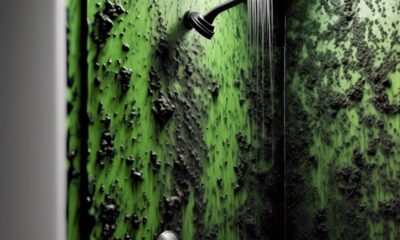Beginners Guides
Perfect Temperature for Pancakes

The key to making the perfect pancakes lies in finding the ideal temperature for cooking.
It's like trying to hit the bullseye on a dartboard – precision is everything.
But how do we know what that perfect temperature is? And why does it matter so much?
Well, let's dive into the science behind pancake cooking temperatures and uncover the factors that can make or break your pancake game.
Key Takeaways
- Finding the ideal temperature is key for cooking perfect pancakes
- Heat distribution across the cooking surface is crucial for consistent browning and texture
- Preheating the cooking surface to around 350°F is a good starting point
- Adjusting the temperature during the cooking process is crucial for desired results
Understanding the Science Behind Pancake Cooking Temperatures
Understanding the science behind pancake cooking temperatures allows us to achieve optimal texture and flavor by manipulating the Maillard reaction. Heat distribution plays a crucial role in pancake cooking. When the batter is poured onto the griddle or pan, the heat from the cooking surface rapidly conducts into the batter. This process sets off a series of chemical reactions. As the batter heats up, the water content begins to evaporate, and the proteins and carbohydrates undergo the Maillard reaction. This reaction is responsible for the golden-brown color and the characteristic nutty, caramelized flavor of the pancakes.
To ensure that the Maillard reaction occurs evenly, proper heat distribution is essential. An unevenly heated cooking surface can result in uneven browning and texture. It's crucial to preheat the cooking surface adequately and maintain a consistent temperature throughout the cooking process.
Furthermore, the chemical reactions occurring in the pancake batter are highly sensitive to temperature. Therefore, understanding the science behind pancake cooking temperatures is imperative for achieving the perfect texture and flavor in our pancakes.
Factors Affecting Pancake Cooking Temperatures

Maintaining proper heat distribution is crucial for achieving consistent browning and texture when cooking pancakes. Heat distribution refers to how evenly heat is spread across the cooking surface. Uneven heat can result in pancakes that are unevenly cooked, with some parts being overdone while others are undercooked. To ensure even heat distribution, using a flat, heavy-bottomed griddle or skillet is essential. These types of cookware help to spread the heat evenly, resulting in uniformly cooked pancakes.
Batter consistency also plays a significant role in determining the ideal cooking temperature for pancakes. The thickness of the batter affects how quickly it cooks and how evenly it spreads on the cooking surface. A thicker batter will require lower heat to ensure that the pancakes cook through without burning on the outside. Conversely, a thinner batter may necessitate slightly higher heat to ensure that the pancakes cook to the desired consistency.
Understanding the interplay between heat distribution and batter consistency is essential for mastering the art of cooking perfect pancakes. By adjusting these factors, one can achieve optimal cooking temperatures for consistently delicious results.
Tips for Finding the Perfect Pancake Cooking Temperature
To determine the perfect cooking temperature for pancakes, it's important to consider the characteristics of the batter and the heat distribution of the cooking surface. Finding the right heat is crucial in achieving the desired golden-brown color and fluffy texture of pancakes.
A useful tip is to preheat the cooking surface to a medium heat level, around 350°F, and then adjust as needed. This allows for a good initial heat distribution, giving the pancakes a solid start without burning them.
Once the batter is poured onto the cooking surface, observe the edges for small bubbles. When the edges appear slightly dry and small bubbles form on the surface, it's time to flip the pancake. Perfect flip timing is key to ensuring even cooking on both sides. Typically, this occurs after 1-2 minutes of cooking on the first side.
Adjusting the heat as necessary during the cooking process is also important. Too high of a temperature can lead to uneven cooking, while too low of a temperature can result in pale and dense pancakes.
Testing and Adjusting Pancake Cooking Temperatures
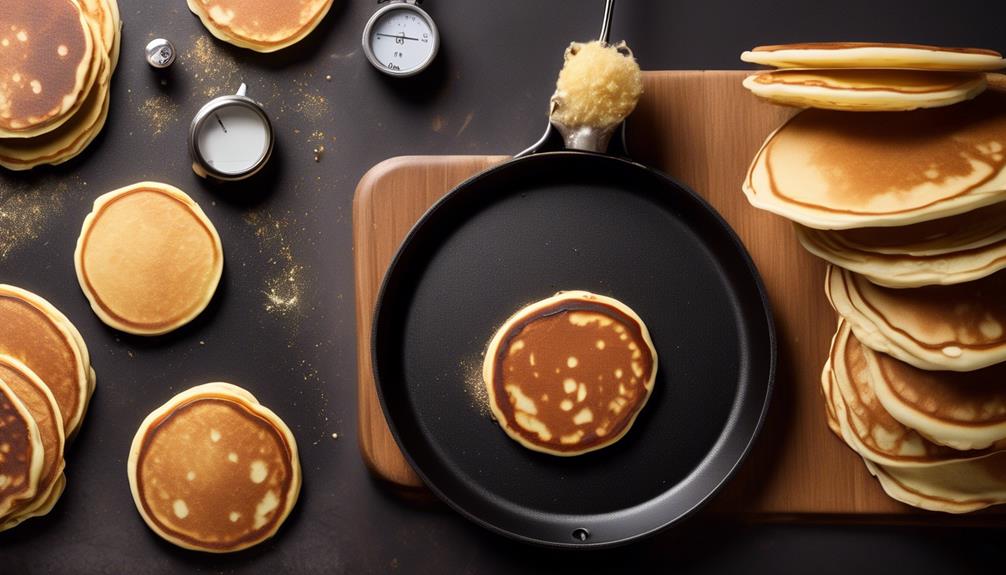
We conducted thorough experiments to evaluate the impact of varying cooking temperatures on the texture and color of pancakes. Through our rigorous testing, we were able to pinpoint the optimal temperature range for achieving the perfect pancake.
- Temperature Variations
We observed that temperatures between 375°F and 400°F consistently produced pancakes with a golden-brown color and a fluffy texture. Higher temperatures led to overly browned exteriors and dry, tough pancakes, while lower temperatures resulted in pale, undercooked pancakes with a dense texture.
- Cooking Techniques
Adjusting the temperature on the griddle or skillet during the cooking process proved to be crucial. Starting with a slightly higher temperature for the initial pour of the batter helped to create a desirable outer crust, while reducing the temperature for the remainder of the cooking time ensured that the inside of the pancake cooked evenly without burning the surface.
Our findings emphasize the importance of maintaining precise temperature control and making temperature adjustments during the cooking process to achieve consistently perfect pancakes.
Common Mistakes to Avoid When Cooking Pancakes
After pinpointing the optimal temperature range for achieving the perfect pancake, it's important to be aware of common mistakes to avoid when cooking pancakes.
One of the most common mistakes is over mixing the pancake batter. Over mixing can lead to dense and tough pancakes as it overdevelops the gluten in the flour. To prevent this, mix the batter until the dry ingredients are just incorporated. Small lumps in the batter are okay and actually indicate that the batter isn't over mixed.
Another frequent mistake is flipping the pancake too early. It's crucial to wait for the right moment to flip the pancake. This is indicated by the formation of bubbles on the surface of the pancake, which then pop and form little craters. Once this happens, and the edges are slightly set, it's time to flip. Flipping too early can result in unevenly cooked pancakes.
Being mindful of these common mistakes will help ensure that your pancakes turn out light, fluffy, and delicious.
Frequently Asked Questions
Can I Use a Different Type of Flour for Making Pancakes, and How Does It Affect the Cooking Temperature?
We can use different flour types for making pancakes, and it affects the cooking temperature.
Various flours like whole wheat, almond, or coconut alter the temperature due to their unique properties.
Whole wheat requires a slightly lower cooking temperature due to its denser texture, while almond and coconut flour need a lower temperature due to their higher fat content.
These variations also impact flavor profiles and texture differences in the pancakes.
Does the Type of Pan I Use Affect the Recommended Cooking Temperature for Pancakes?
The type of pan definitely affects the recommended cooking temperature for pancakes. Different materials conduct heat differently, impacting how evenly the pancakes cook.
For example, a nonstick pan may require a lower temperature to prevent the pancakes from burning, while a cast iron pan might need a slightly higher temperature for optimal cooking.
Understanding the effect of pan type on cooking temperature adjustment is essential for achieving the perfect pancakes every time.
Are There Any Health Risks Associated With Cooking Pancakes at Higher Temperatures?
Cooking pancakes at high temperatures can pose health risks. When pancakes are cooked at elevated temperatures, there's a risk of creating potentially harmful compounds, such as acrylamide. These compounds can have negative effects on health.
It's important to consider the cooking temperature and adjust accordingly to minimize these risks. Awareness of the impact of cooking temperature on pancake preparation can lead to healthier outcomes.
Can I Use an Electric Griddle Instead of a Stovetop for Cooking Pancakes, and How Does It Affect the Cooking Temperature?
We can use an electric griddle instead of a stovetop for cooking pancakes. The electric griddle provides precise temperature control, which can result in more consistent and evenly cooked pancakes. It may require some cooking adjustments due to differences in heat distribution, but overall, an electric griddle can be a convenient and efficient alternative for making pancakes.
Flour alternatives can also be explored for various dietary needs or preferences.
How Does the Altitude at Which I Am Cooking Affect the Recommended Cooking Temperature for Pancakes?
At higher altitudes, the effect of altitude on pancakes is significant, leading to cooking temperature variations. Due to lower air pressure, liquids evaporate more quickly, and leavening agents expand more. This affects the cooking time and the optimal temperature for pancakes.
It's recommended to lower the cooking temperature by 15-25°F for every 5,000 feet of altitude. Understanding these adjustments is crucial for achieving perfect pancakes at different altitudes.
– What Is the Ideal Temperature for Cooking Pancakes in an Electric Skillet?
The ideal electric skillet pancake temperature is around 375°F. This allows the pancakes to cook evenly and reach a golden-brown color. Preheat the skillet for a few minutes before pouring the batter. Adjust the heat as needed during cooking to ensure the pancakes are not burning.
Conclusion
In conclusion, finding the perfect temperature for cooking pancakes is crucial for achieving that ideal golden brown color and fluffy texture. By understanding the science behind pancake cooking temperatures and considering factors such as batter consistency and cooking surface, one can ensure consistent and perfect results.
Remember to test and adjust the cooking temperature as needed, and avoid common mistakes like cooking at too high of a temperature.
With a little experimentation, you'll be flipping out perfect pancakes in no time.
- About the Author
- Latest Posts
Introducing Ron, the home decor aficionado at ByRetreat, whose passion for creating beautiful and inviting spaces is at the heart of his work. With his deep knowledge of home decor and his innate sense of style, Ron brings a wealth of expertise and a keen eye for detail to the ByRetreat team.
Ron’s love for home decor goes beyond aesthetics; he understands that our surroundings play a significant role in our overall well-being and productivity. With this in mind, Ron is dedicated to transforming remote workspaces into havens of comfort, functionality, and beauty.
Beginners Guides
Ritz-Carlton Yacht Collection Embarks on Ilma's Construction Journey
Heralding a new era of luxury cruising, the Ritz-Carlton Yacht Collection's Ilma promises innovative design and exclusive amenities – a must-read for discerning travelers.

Have you ever wondered what sets the Ritz-Carlton Yacht Collection apart from other luxury cruise experiences?
As Ilma's construction journey commences, one can't help but speculate about the innovative design elements and unique features that will distinguish this yacht.
From its environmentally friendly practices to the promise of exclusive amenities, Ilma seems poised to redefine luxury travel at sea.
Key Takeaways
- Ilma is the second yacht in The Ritz-Carlton Yacht Collection with 224 suites.
- Construction progress includes a significant float out ceremony and meticulous outfitting.
- Scheduled sea trials for Ilma are set to commence in April 2024.
- Ilma's design features sustainable practices, luxurious amenities, and diverse dining options.
Luxury Yacht Ilma: Construction Updates
Embarking on its construction journey, the opulent Ilma yacht of The Ritz-Carlton Yacht Collection stands at 790 feet in length, promising an exquisite haven for up to 448 guests in its 224 suites with private terraces.
The Chantiers de l'Atlantique shipyard in France witnessed a significant construction milestone with a grand float out ceremony for the magnificent Ilma.
Following this milestone, the focus shifts to outfitting the vessel, where the interiors, fixtures, and fittings for the lavish suites and public spaces will be meticulously curated to secure a luxurious experience for all guests.
Anticipation builds as scheduled sea trials for Ilma are on the horizon, set to commence in April. The excitement culminates in the much-awaited maiden voyage of the Ilma in 2024, promising a voyage filled with opulence and unparalleled luxury on the seas.
Stay tuned for more updates on this extraordinary journey of the Ilma yacht.
Design and Features of Ilma
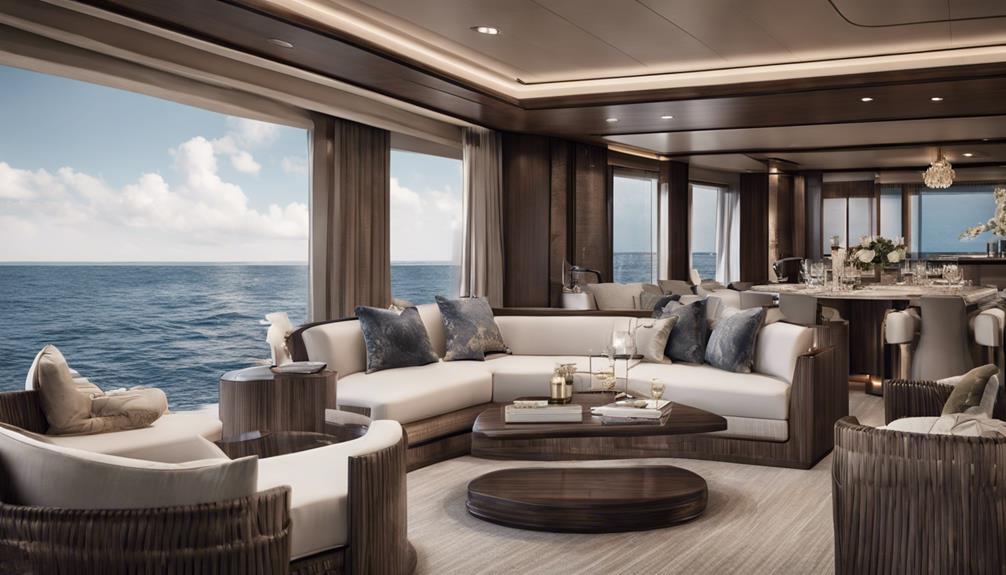
Cruising the expanse of luxury and innovation, Ilma, the second yacht in The Ritz-Carlton Yacht Collection, exposes a mesmerizing blend of opulent design and cutting-edge features. Boasting 224 suites with private terraces, Ilma can accommodate up to 448 guests in style and comfort. The suite categories on board cater to various preferences, ranging from the luxurious Owners Suite to the elegant Concierge Suite, ensuring a tailored experience for every guest.
As part of its exceptional offerings, Ilma features a Marina for indulging in exciting water activities, a state-of-the-art Ritz-Carlton Spa for relaxation, and a fully equipped gym for those seeking to stay active while at sea. Dining on Ilma is a culinary journey with five diverse dining options providing high-quality culinary experiences that are sure to delight discerning taste buds. Additionally, guests can expect nothing short of exceptional service standards that reflect The Ritz-Carlton's renowned commitment to excellence. Ilma promises a voyage filled with luxury, comfort, and unforgettable experiences.
The Ritz-Carlton's Yachting Experience
Starting The Ritz-Carlton's yachting adventure reveals a domain of unmatched opulence and personalized service tailored to surpass every guest's expectations. The Ritz-Carlton Yacht Collection's Ilma promises an extraordinary onboard experience that encapsulates the essence of a luxury lifestyle.
Here are three key highlights that make sailing on Ilma an unforgettable journey:
- Luxurious Suites: With a total of 224 suites featuring private terraces, Ilma can accommodate up to 448 guests in unparalleled comfort and style.
- Diverse Dining Venues: Ilma offers a culinary delight with five distinct dining venues, ensuring a variety of gourmet experiences that cater to every palate.
- Curated Itineraries: Guests aboard Ilma can look forward to meticulously planned itineraries that explore enchanting destinations in the Mediterranean, Caribbean, and Central America, providing a perfect blend of relaxation and adventure.
Immerse yourself in the world of The Ritz-Carlton's yachting experience aboard Ilma, where every moment is crafted to indulge your senses and elevate your journey to new heights.
Sustainable Practices on Ilma

Embark on a journey aboard Ilma with a dedication to sustainable practices that harmonize luxury with environmental responsibility. Our commitment to sustainable practices is evident in every detail of the Ilma yacht. From energy-efficient lighting to water-saving fixtures, we aim to minimize our environmental impact at every turn. Advanced waste management systems onboard guarantee that waste is reduced and recycled efficiently during voyages, showcasing our dedication to environmental stewardship.
At the forefront of sustainability, Ilma is equipped with state-of-the-art technology that not only enhances the guest experience but also conserves energy. Throughout the construction and operations of Ilma, sustainable materials and eco-friendly design elements have been carefully integrated, reflecting our green initiatives and commitment to eco-conscious practices.
As part of the Ritz-Carlton Yacht Collection, Ilma embodies a culture of environmental stewardship, where luxury and sustainability coexist seamlessly. Join us aboard Ilma to experience the beauty of green initiatives firsthand.
Unveiling Ilma's Exclusive Amenities
Prepare to indulge in a world of luxury and comfort aboard Ilma as we introduce its exclusive amenities designed to elevate your cruising experience to new heights.
- Marina for Water Sports: Thus into the crystal-clear waters right from the yacht's Marina, offering a variety of water sports activities for thrill-seekers and water enthusiasts.
- Ritz-Carlton Spa: Relax and rejuvenate at the renowned Ritz-Carlton Spa onboard Ilma, where you can pamper yourself with luxurious treatments and unwind in a tranquil setting.
- Diverse Dining Experiences: Explore five distinct venues on Ilma, each offering a unique culinary journey with diverse menu selections curated to tantalize your taste buds. From casual bites to fine dining experiences, savor exceptional service standards while enjoying the panoramic views of the sea.
With these exclusive amenities, Ilma promises a luxurious and unforgettable cruising experience where you can enjoy handcrafted cocktails at Marina Terrace, stay active at the full-service gym, and indulge in exceptional dining experiences tailored to exceed your expectations.
Conclusion
As Ilma gracefully takes to the water, we're captivated by the promise of luxurious adventures that await onboard. With 224 exquisite suites and unparalleled service, The Ritz-Carlton Yacht Collection sets sail towards a new era of opulence and sophistication.
The thought of sun-kissed decks, gourmet dining under the stars, and personalized pampering beckons us to join this extraordinary voyage. Ilma's construction journey is just the beginning of a seafaring dream come true.
- About the Author
- Latest Posts
Introducing Ron, the home decor aficionado at ByRetreat, whose passion for creating beautiful and inviting spaces is at the heart of his work. With his deep knowledge of home decor and his innate sense of style, Ron brings a wealth of expertise and a keen eye for detail to the ByRetreat team.
Ron’s love for home decor goes beyond aesthetics; he understands that our surroundings play a significant role in our overall well-being and productivity. With this in mind, Ron is dedicated to transforming remote workspaces into havens of comfort, functionality, and beauty.
Beginners Guides
Best Time to Do Cruise Ships Depart: A Guide
Keen on optimizing your cruise ship embarkation? Timing is everything – discover the ideal departure window for a seamless boarding experience.
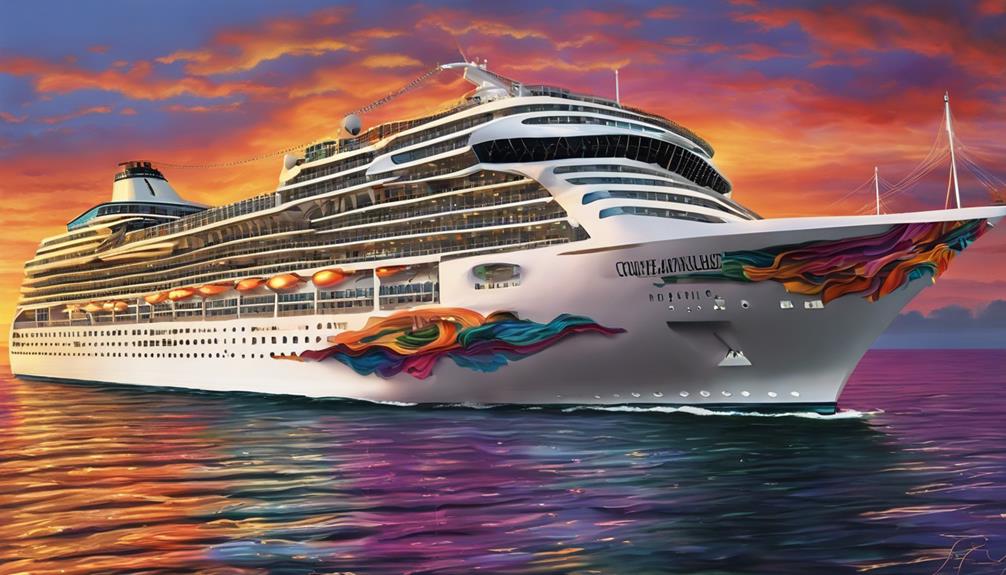
When considering the best time for cruise ship departures, we must navigate through a sea of factors to make sure a smooth embarkation.
From determining the ideal arrival window to seizing the moment for a hassle-free boarding process, timing is critical.
Let's explore the intricacies of setting sail at the best hour to kickstart your maritime adventure with finesse.
Key Takeaways
- Cruise ships generally depart in late afternoon or early evening for optimal guest experience.
- Factors like port schedules, boarding ease, and safety protocols influence departure times.
- Timing varies by cruise line, port, and itinerary, with early arrival ensuring smooth boarding.
- Aim for late afternoon or early evening boarding, be on board 1-2 hours before sailing for a seamless start.
Optimal Departure Times for Cruise Ships
When planning the best departure times for cruise ships, we carefully consider various factors to guarantee a smooth and enjoyable boarding experience for passengers. Cruise ships typically set sail in the late afternoon or early evening, allowing guests ample time to board, settle in, and start their cruise experience. Arriving early at the port is important to complete the boarding process efficiently and participate in mandatory safety drills before setting off on the journey.
The allure of early evening departures lies in the opportunity to witness stunning views of the sunset while the ship glides away from the port. These specific departure times are strategically planned by cruise lines to ensure smooth boarding and timely sailing. By setting sail during this magical time, passengers can relax on deck, soak in the breathtaking scenery, and kick off their vacation in style. The combination of practicality and beauty makes late afternoon and early evening departures a favorite among travelers seeking a seamless and memorable cruise experience.
Factors Affecting Departure Time Choices
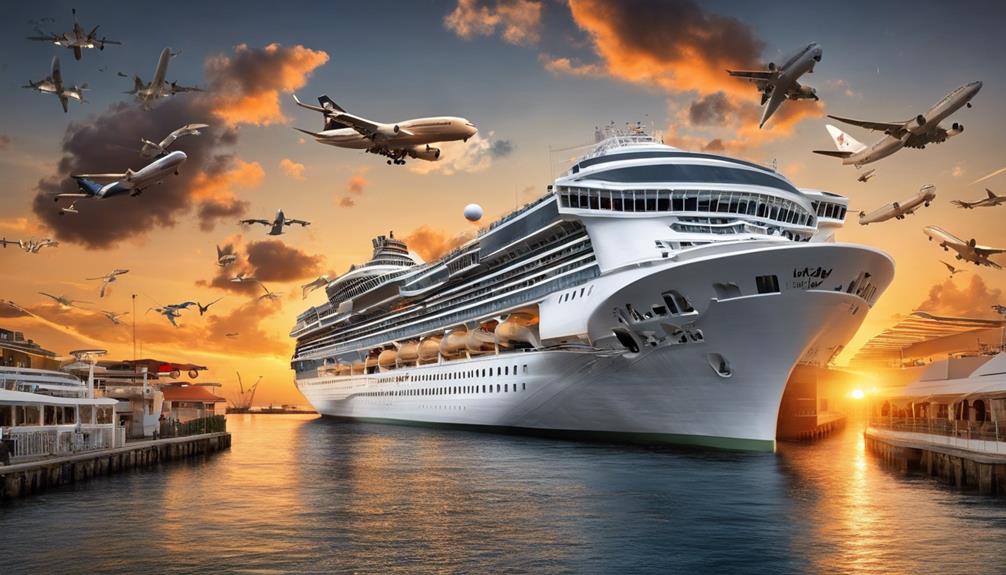
Considering various factors such as port schedules, passenger boarding, and safety protocols, cruise lines carefully determine the best departure times for their ships.
- Port Schedules: Cruise ship departure times are often influenced by the availability of ports and their schedules to guarantee smooth sailing.
- Passenger Boarding: The ease and efficiency of passenger boarding play a critical role in setting departure times for the convenience of travelers.
- Safety Protocols: Adhering to strict safety protocols is essential, affecting the timing of departures to make sure the well-being of all onboard.
- Logistical Considerations: Various logistical factors, including fueling, provisioning, and maintenance, impact the decision-making process for departure times.
Best Times for Cruise Ship Departures
What factors influence the selection of the best times for cruise ship departures? Cruise ship departures are typically scheduled in the afternoon or early evening to allow passengers ample time for boarding processes, safety drills, and final preparations before setting sail. The exact departure time can vary depending on the cruise line, port of embarkation, and itinerary. It's important for passengers to arrive early at the port to complete check-in procedures smoothly. To highlight the importance of timing in cruise ship departures, let's take a closer look at the key considerations:
| Consideration | Importance |
|---|---|
| Boarding Process | Smooth boarding is important for timely departures |
| Safety Drills | Necessary for passenger safety and compliance |
| Final Preparations | Ensuring all systems are go before departure |
Being aware of these factors and the specifics outlined by your cruise line will help you make the most of your cruise ship departure experience.
Ideal Departure Seasons for Cruising
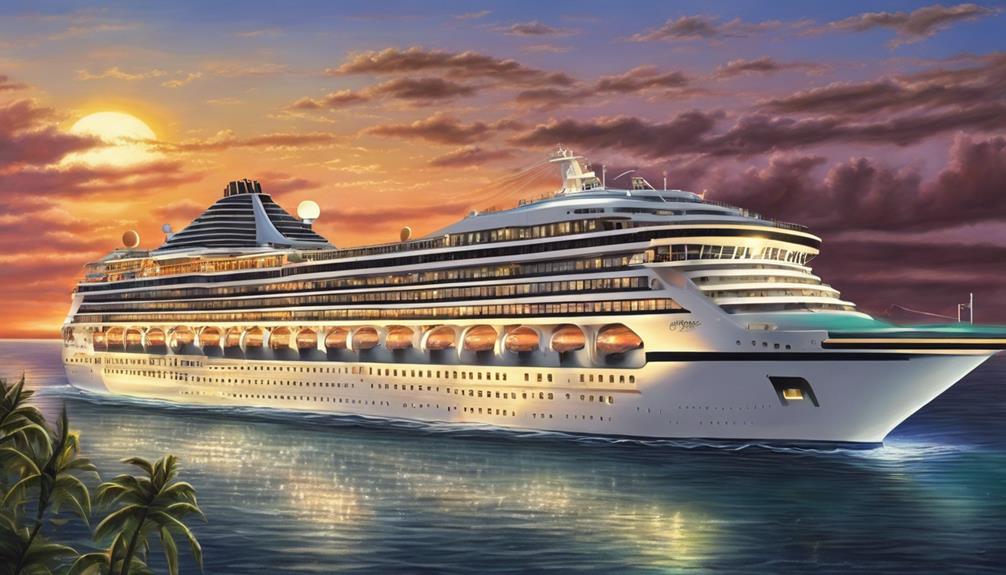
Planning a cruise vacation involves considering the ideal departure seasons for cruising, which vary depending on the region and destination. When booking a cruise, timing your departure right is crucial to enjoy the best weather and make the most of your experience. Here are some key points to keep in mind:
- Alaska Cruises: The best time to go is from mid-April to September when the weather is still relatively warm.
- Caribbean and Bahamas Cruises: Ideal departure seasons are from December to May, avoiding the peak hurricane season.
- Mediterranean Cruises: April-May and September-October offer pleasant weather and fewer crowds, making it an ideal time to explore this region.
- Hawaii Cruises: June to August is perfect for warm weather, but if you're looking for low prices, consider the fall season.
Tips for Timing Your Cruise Departure
To optimize your cruise experience, timing your departure strategically can enhance the boarding process and set the stage for a smooth sailing ahead. When planning your boarding time, aim for the late afternoon or early evening slot to coincide with the typical departure schedule of cruise ships. This timing allows for a more relaxed boarding process, avoiding the morning rushes often associated with check-ins. Most cruise lines require passengers to be on board 1-2 hours before the ship sets sail, ensuring all necessary procedures are completed smoothly. To expedite the boarding process further, consider utilizing online check-in services and setting up onboard accounts before arrival. Efficient boarding not only benefits passengers by kickstarting their cruise experience promptly but also aids cruise staff in ensuring a timely departure. By following these tips and timing your boarding thoughtfully, you can contribute to a seamless start to your adventure at sea.
| Boarding Times | Late Afternoon | Early Evening |
|---|---|---|
| Recommended Time | 3:00 PM – 5:00 PM | 6:00 PM – 8:00 PM |
| Benefits | Avoids morning rush | Allows for relaxed check-in |
| Passenger Arrival | 1-2 hours before | 1-2 hours before |
Conclusion
To sum up, choosing the best time to depart on a cruise ship is like finding the perfect wave to catch while surfing – timing is everything.
By considering factors like proximity to the port, weather conditions, and personal preferences, you can guarantee a smooth and enjoyable sailing experience.
So, just like riding a wave, make sure to time your departure wisely to catch the best cruise experience possible.
Happy sailing!
- About the Author
- Latest Posts
Introducing Ron, the home decor aficionado at ByRetreat, whose passion for creating beautiful and inviting spaces is at the heart of his work. With his deep knowledge of home decor and his innate sense of style, Ron brings a wealth of expertise and a keen eye for detail to the ByRetreat team.
Ron’s love for home decor goes beyond aesthetics; he understands that our surroundings play a significant role in our overall well-being and productivity. With this in mind, Ron is dedicated to transforming remote workspaces into havens of comfort, functionality, and beauty.
Beginners Guides
Best Time to See Whales on an Alaskan Cruise Revealed
Lose yourself in the secrets of whale-watching in Alaska as we unveil the perfect timing for spotting these majestic creatures on your cruise.
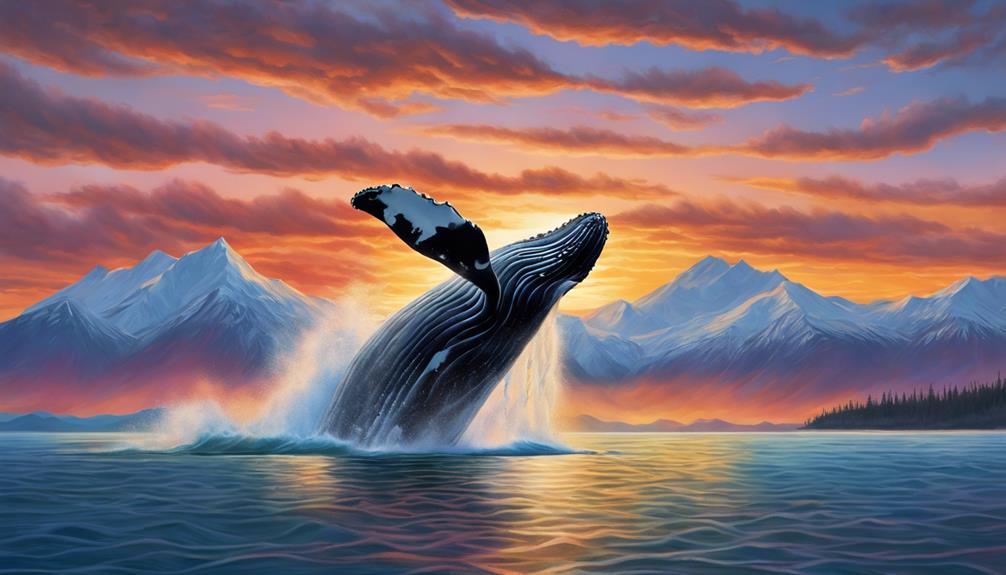
When considering the best time to catch a glimpse of whales on an Alaskan cruise, it is crucial to note that certain months offer better chances for sightings than others.
But did you know that the time of day can also play a role in increasing your likelihood of encountering these majestic creatures?
Understanding when they are most active can greatly enhance your whale-watching experience.
Stay with us to unravel the mysteries of the best time to spot whales in the breathtaking waters of Alaska.
Key Takeaways
- Peak whale-watching season in Alaska is during July and August.
- Early morning hours offer the best chances for whale sightings.
- Whale hotspots like Juneau and Icy Strait Point promise unforgettable encounters.
- Understanding whale behavior helps determine optimal sighting times for a memorable experience.
Peak Whale-Watching Season in Alaska
During the peak whale-watching season in Alaska, enthusiasts can witness a flurry of marine mammal activity along the coastal waters. The warmest months of July and August mark the peak season for whale sightings in Alaska, offering ideal conditions for observing these majestic creatures in their natural habitat.
Wildlife activity is at its best level during the spring and summer months, making it the best time for whale watching excursions. Alaskan cruises during these months provide ample opportunities for spotting whales, with longer daylight hours in June and July enhancing the chances of memorable encounters with these marine giants.
The abundance of food sources and favorable weather conditions attract various whale species to the nutrient-rich waters of Alaska during this period, creating a prime environment for wildlife enthusiasts to enjoy unparalleled whale-watching experiences.
Whether it's the breathtaking sight of humpback whales breaching or the graceful movements of orcas gliding through the waves, the peak whale-watching season in Alaska promises unforgettable moments for those seeking to connect with nature.
Best Locations for Whale Spotting
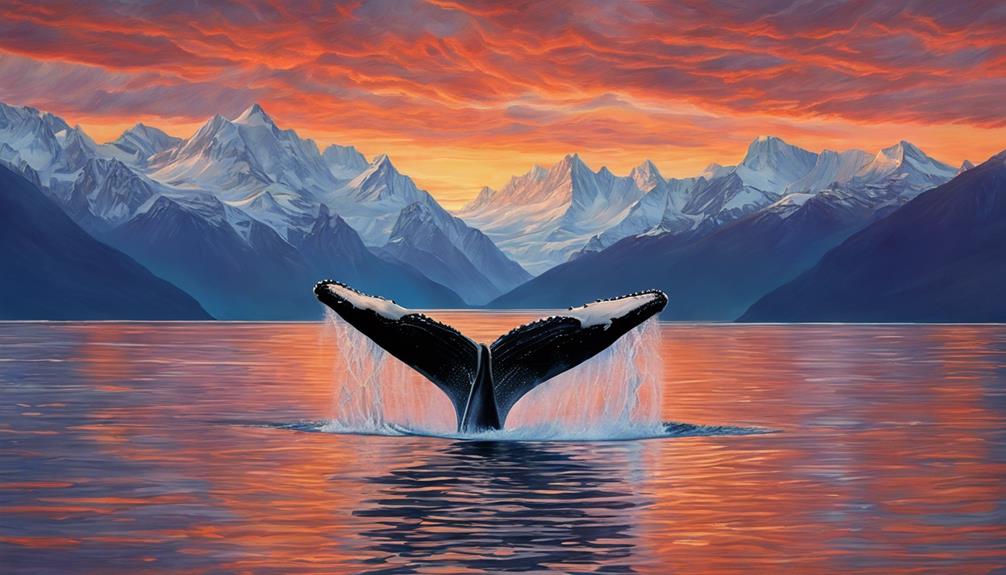
Whale enthusiasts seeking best opportunities for sightings in Alaska should explore the top locations known for guaranteed and varied whale encounters. Juneau stands out as a premier spot for guaranteed whale sightings during an Alaska cruise, while Icy Strait Point offers good whale watching opportunities, although sightings are not always guaranteed. Sitka, along with Victoria and Icy Strait Point, are also among the top ports for whale spotting in Alaska.
—
| Best Whale Watching Ports | Month |
|---|---|
| Juneau | July |
| Icy Strait Point | August |
| Sitka | |
| Victoria |
—
For those looking to catch a glimpse of Blue whales, the best time to visit Alaska is typically in July and August. These months offer best conditions for witnessing these majestic creatures in their natural habitat. Whether it's the bustling waters of Juneau or the serene beauty of Sitka, Alaska's diverse whale watching ports provide an unforgettable experience for nature lovers.
Optimal Time of Day for Whale Sightings
In perfect conditions, morning light enhances visibility for spotting whales in Alaska. When considering the best time of day for whale sightings in Alaskan waters, several factors come into play:
- Early Morning Hours: Whales can be seen at any time of day, but early morning hours often provide the best chances for whale sightings due to calmer seas and better lighting conditions.
- Weather Conditions: The best time of day can vary based on weather conditions. Clear skies and calm waters can make whale sightings more likely throughout the day.
- Whale Behavior and Feeding Habits: Understanding whale behavior patterns and feeding habits can help determine the most suitable time of day to spot them during a cruise. Whales may be more active during certain times of the day, influencing the best timing for whale watching excursions.
Considering these factors, the period from sunrise to late morning is a popular time frame for whale watching excursions in Alaska, offering a higher probability of encountering these magnificent creatures in their natural habitat.
Types of Whales You May Encounter
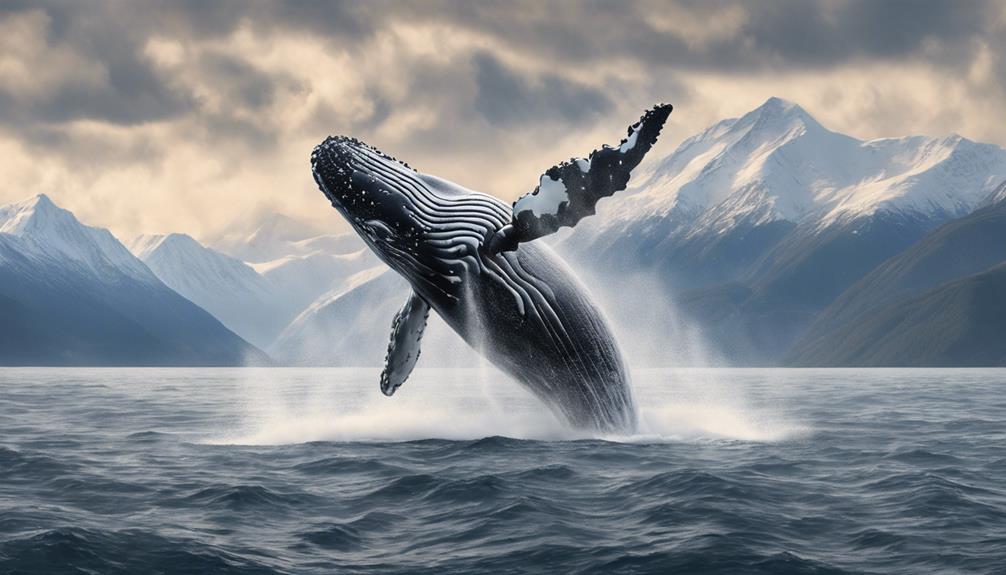
Throughout the peak season from May to September, our Alaskan whale watching excursions offer sightings of various whale species, including humpbacks, orcas, blues, and belugas.
Humpback whales, known for their acrobatic breaching behavior, are commonly observed in Alaska during June and July, providing mesmerizing displays for onlookers.
Orca whales, also referred to as killer whales, can be best spotted in Alaskan waters from early May to June, showcasing their distinctive black and white markings as they glide through the ocean.
The majestic blue whales, the largest animals on Earth, grace the Alaskan waters in July and August, their immense size leaving a lasting impression on all who are fortunate enough to witness them.
Additionally, the critically endangered beluga whales can be seen near Anchorage in Alaska, offering a rare opportunity to observe these unique and threatened creatures in their natural habitat.
Alaska truly provides a diverse and enchanting array of whale species for unforgettable whale watching experiences during the peak season.
Tips for Maximizing Whale-Watching Experience
Maximizing the whale-watching experience involves strategically positioning oneself on open-air decks, staying alert for crew announcements, and equipping with essential gear for best viewing conditions.
- Utilize open-air decks on the cruise ship for best whale viewing.
- Listen for announcements from the crew about whale sightings during the cruise.
- Consider booking a veranda stateroom or suite for a better vantage point.
To enhance your whale-watching experience during an Alaskan cruise, keenly observe the surroundings for telltale signs of whales in the wild. Keep an eye out for blowhole plumes, which are a clear indicator of nearby whales. Additionally, having binoculars on hand can help you spot these majestic creatures more easily.
For capturing memorable moments, equip yourself with a high-resolution camera and a sturdy camera strap to secure your equipment. Don't forget to pack a dry bag to protect your gear from any unexpected splashes. Dressing appropriately for the weather conditions ensures you stay comfortable while enjoying the beauty of whale sightings.
Conclusion
By following the best timing and locations, we can reveal the secrets of the deep, connecting with these remarkable creatures on a profound level.
Like skilled astronomers gazing into the vast expanse of the universe, we're privileged to witness the graceful dance of humpback whales and the powerful presence of orcas in their natural habitat.
This peak season for whale watching in Alaska offers a window into the majestic world of these marine giants.
- About the Author
- Latest Posts
Introducing Ron, the home decor aficionado at ByRetreat, whose passion for creating beautiful and inviting spaces is at the heart of his work. With his deep knowledge of home decor and his innate sense of style, Ron brings a wealth of expertise and a keen eye for detail to the ByRetreat team.
Ron’s love for home decor goes beyond aesthetics; he understands that our surroundings play a significant role in our overall well-being and productivity. With this in mind, Ron is dedicated to transforming remote workspaces into havens of comfort, functionality, and beauty.
-

 Vetted3 weeks ago
Vetted3 weeks ago15 Best Contact Paper for Kitchen Cabinets to Elevate Your Home Decor
-

 Vetted2 weeks ago
Vetted2 weeks ago15 Best Poe Cameras for Home Security – Reviews & Buying Guide
-

 Vetted4 weeks ago
Vetted4 weeks ago15 Best Leather Restorer Products to Revive Your Furniture and Accessories
-

 Vetted3 weeks ago
Vetted3 weeks ago15 Best Drain Snakes to Unclog Your Pipes Like a Pro
-

 Beginners Guides3 days ago
Beginners Guides3 days agoI Inhaled Vinegar Fumes
-

 Vetted4 weeks ago
Vetted4 weeks ago14 Best Stationery Brands for Your Next Writing Adventure
-

 Beginners Guides2 weeks ago
Beginners Guides2 weeks agoSwinger Porch Light Color
-

 Mardi Gras Decoration3 weeks ago
Mardi Gras Decoration3 weeks agoWhy Does Hobby Lobby Not Do Mardi Gras?



















